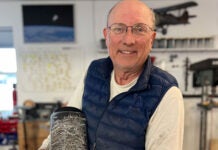Tim Shanklands Zenith 601 HD

I received my plans on October 1, 1998, and have worked on the plane since then. This is a plansbuilt aircraft, and I learned many invaluable skills in its construction. The better part of a year was needed just to design, build and test the cooling system. When asked why it took so long my answer always is, “Life intrudes.” Nevertheless, I took my bird on its first flight in April of 2007 after the 40 hours were finally flown off. My wife was my first passenger for all those years of seeing me disappear into the shop. The plane is powered by a 100-hp Stratus Subaru equipped with a ground-adjustable Warp Drive prop. I have a full IFR panel and a laptop computer for flight and engine data recording. Of course, I could also use it for those in-flight movies. The plane is equipped with an all-electric panel and dual main power buses and batteries. The aluminum is polished, and the cowling and wheelpants are fiberglass of my own design. The online help of the Matronics user groups was great for those odd questions, as someone had always been there before you. I must thank my wife for her understanding about all the money and time spent and all those online and local who were ready to answer my questions.
Pickerington, Ohio
tshankland@sbcglobal.net
Daniel Snows RV-9A

N214D received its Airworthiness Certificate on April 25, 2007, and had an uneventful first flight on April 27. The “slow-build” construction took 1850 hours over a period of 16 months. Empty weight came in at 1064 pounds, including a full Classic Aero Designs interior, Garmin IFR panel, and Grand Rapids Sport EFIS/EIS. The Sensenich fixed-pitch prop is powered by Superiors smooth-running XP-O-320. Im grateful to my son, Brian, for his help on those hard-to-reach places, and a very big “thank you” is due my wife, Carla, for several hours of riveting and for putting up with an obsessive pilot/husband.
Pell City, Alabama
daniel.snow@coosahs.net
Stan Levandowskis RANS S-4 Coyote

I finished my Coyote I in 849.5 hours over a 2-year period. I wanted a simple yet reliable single-place airplane that I would finish and would be proud to own. I opted for the HKS700E 60-hp four-stroke engine for Afternoon Delight. This required a custom engine mount designed and built by Lost Hill Aviation. I fabricated a larger panel and equipped it with all the necessary day VFR and engine gauges. A Kuntzleman Hot Box specific to the HKS made wiring much easier. A BRS-800 softpack was nestled between the longerons aft of the seat, along with the gascolator, electric fuel pump and battery. Two 9-gallon wing tanks give me plenty of range, and check valves prevent cross feeding. A strobe light and an ELT provide some additional safety for cross-country flight. The full range of RANS options, such as upgraded seat, custom colors, doors and so forth, were incorporated. I hung a 68-inch Powerfin “F” blade prop. The HKS muffler would not fit under the cowling, so I installed a SuperTrapp instead. Then I sprayed it with clear coat-six times. All this added some weight, which increased stall speed on paper. I put Harrison VGs on the wings and underside of the horizontal stab to compensate for this. FAA Albany FSDO signed it off in mid-July 2006 with no squawks! First flight was made late in the afternoon of August 12, 2006. Takeoff weight was 760 pounds, and I was off the ground in 4 seconds. Handling was delightful. I flew around for an uneventful half hour and brought Afternoon Delight back to earth in a perfect three-point landing.
Fishkill, New York
sl219@optionline.net
Larry Landuccis Zenith CH 801

My dream airplane was completed in three years. My friend Pete helped with the rudder at a workshop at the Zenith factory, and my wife, Jackie, and our friend Sally helped with sewing and upholstery projects in the cabin. The engine is a 180-hp Lycoming O-360. The 801 is equipped for day and night VFR and has auxiliary gas tanks. During the three years of building, I had frequent consultations with the friendly Zenith folks for advice and help conveyed through telephone conversations and emails. I had a total of five inspections by EAA Technical Counselors Al Barger and Dax Wanless for the engine and accessories and Bill Rewey for the airframe. My sons Bill and Lou provided technical help and the initial “push” to follow their lead in obtaining a Private Pilot license and to build an airplane as they had a few years earlier (Pulsar and Kitfox). In preparation for flight testing, I attended the EAA SportAir workshop “Flying Your Project,” instructed by the late Bill Bateman. In the summer of 2005 I obtained my Airworthiness Certificate after a thorough examination by Tim Peterson from the Milwaukee FSDO. My first flight, supervised by my flight advisor Bob Ward, was performed in September 2005. Now with more than 230 hours on the Hobbs, my wife and I have been to nine states. Needless to say, this Chris Heintz-designed aircraft is everything-and more-than I hoped for.
Verona, Wisconsin
lllanducci@tds.net
BUILDERS SHARE THEIR SUCCESSES
Submissions to “Completions” should include a typed, double-spaced description (a few paragraphs only-250 words maximum) of the project and the finished aircraft. Also include a good color photograph (prints or 35mm slides are acceptable) of the aircraft that we may keep. Please include a daytime phone number where we can contact you if necessary. Also indicate whether we may publish your address in case other builders would like to contact you. Send submissions to: Completions, c/o
KITPLANES Magazine, 203 Argonne Ave., Suite B105, Long Beach, CA 90803. Digital submissions are also acceptable. Send text and photos to editorial@kitplanes.com with a subject line of “Completions.” Photos must be high-resolution-300 dpi at a 3 x 5 print size is the minimum requirement.












